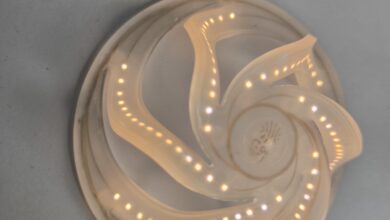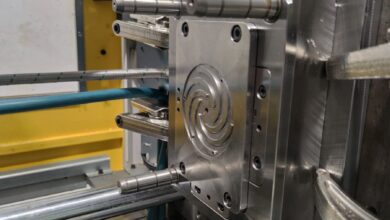- Drive to make additive manufacturing more sustainable
- Sustainability from an ecological but also economical point of view
- Collecting locally, producing locally and printing locally
Making high-quality metal powder for additive manufacturing (AM) or 3D printing from scrap: in a nutshell, this is what the Italian startup f3nice does. Behind this is a vision of sustainability, closed local material cycles and becoming independent from long and complex supply chains with all the risks this entails.
During the first Covid19 lockdown, Matteo Vanazzi, co-founder and CTO of f3nice, and the other founders got the idea to start producing metal powder from metal scrap, in order to avoid supply chain interruptions. They ended up in Greek mythology in their search for a company name. Fenix (or Phoenix), the mythical bird that rises from the ashes of the old Fenix. Only stronger. Fenix as a symbol of renewal. If you take the phonetic spelling of Fenix the Italian way and replace the letter ‘e’ with a 3 (because of the number of the original founders and because of 3D printing), you end up with the name f3nice.
f3nice wants to move additive manufacturing more to a circular technology

Circular and less dependent
Vanazzi often uses this story to start a conversation with potential customers, suppliers or partners. Because the story about the bird from Greek mythology tells exactly what f3nice does, only the powder is not created from ashes but from metal scrap. With this, f3nice kills several birds with one stone. Metal 3D printing is becoming more sustainable, and metal companies are becoming less dependent on long supply chain cycles. They are moving towards the circular use of materials. Their own scrap from machining, rejected parts or components that are no longer needed, is returned to the company as a valuable raw material for a sustainable process: additive manufacturing.
Shorter chain
The three founders – Matteo Vanazzi, Luise E. Mondora (who knew each other from their studies at Politecnico di Milano) and Philip Hansteen (before in Equinor ASA) – are mainly driven to make additive manufacturing more sustainable. “They say that AM is sustainable because you only add the material that you need. Even though this is true, it does have its limitations. The AM process itself is very energy-intensive, and the production of the powders also requires a lot of energy,” says Vanazzi. Besides, the founders of f3nice believe that there are too many steps in the production process of metal powder. First you make metal semi-products from the powder, which machining companies can make components from, and then you reduce that to powder. Bottom line, this means that metal powder production is expensive and requires a lot of energy. The difficulties metal companies experienced in 2020 to get raw materials, as lockdowns had shut down supply chains, were the push the founders needed. “We wanted to use a raw material that is abundant in Italy and Europe: scrap metal. This makes the industry less dependent on supply chains.”



Clean feedstock and digital warehouses
F3nice has patented a number of steps in the process. These mainly relate to the process steps before the scrap enters the furnace. “Our most important contribution lies in everything that precedes it: the collection of the scrap, the quality control and the final mixing of the scrap.” Two of the core competencies of f3nice are sorting and cleaning the scrap, removing grease, oil and residues of metalworking fluid, together with other impurities. The quality of the scrap has often turned out to be the bottleneck in similar developments as those at f3nice. Both for the stability of the laser powder bed process and for the consistent quality of the end-product, one must be sure that there is no contamination in the feedstock and that it is as pure as possible in composition. That is why the Italian startup prefers to collect the scrap directly from the metal companies, not from scrap dealers. This allows f3nice to immediately request all information about the quality and chemical composition. Moreover, it prevents cross contamination. “These companies understand this better than scrap dealers, who in essence just trade the material. Instead, a company that produces this type of scrap knows from their processes where it comes from, what material they have processed, and so on.” The scrap can be chip waste in stainless steel or nickel alloys, but also offshore cables from which the copper is extracted. Increasingly, f3nice is entering discussions with companies that are replacing their physical stock of spare parts with digital warehouses and on-demand production. The old parts can be processed into powder.
Collaboration with partners
F3nice relies on partners who already have mastered the atomization technology to cooperate on the actual production of the powder. “We have not developed any new equipment, because we work with companies that have the technology to produce powder in-house. We have adapted the process to be able to feed these systems with scrap instead of new metal.” However, it has developed a recipe and keeps the quality control of the powder in its own hands.
Economically feasible
Most companies for which f3nice produces metal powder want a closed loop. Yet f3nice sometimes says no to applications. The process must not only be technically feasible, it must also make economic sense, says Vanazzi. “The process must be sustainable from an environmental point of view, but also from an economic perspective. There’s no point in producing something that costs much more than something you just buy in the store. The prices of our powders are competitive; they are slightly above average powder prices. We don’t want you to have to pay more because the powder is ‘green’.” The threshold to start therefore is low. In an R&D process for companies, f3nice can produce several kilograms of powder. If a closed cycle is created together with a company, the aim is to produce 500 to 1,000 kilograms of powder as a starting point. The starting point here is that the powder can be used immediately and that users hardly have to tweak their AM machines to get a good result. “We have to deliver a material that is basically plug and play. This is not always easy, but that is our problem and not that of the customer.”
Local for local
Sustainable metal printing also means that you are not going to ship raw materials all over the world. F3nice tries to keep the CO2 impact in logistics as limited as possible. The founders’ dream is that -together with partners- they can serve companies within a radius of up to 1,000 kilometers. Collecting scrap metal locally, producing powder locally and thus 3D printing locally. The company has recently defined regions in the world where the concept can be viable. The Middle East with Saudi Arabia for example. The American import duties also make the concept attractive there: producing local powder from scrap metal to avoid tariffs.

3DoP project: quality proven
Through the 3DoP project, f3nice has mainly managed to expand their network. “We are very keen on innovation and research. We strongly believe that looking for innovation is just as important as having a viable business here, so our company is very engaged in R&D projects,” Vanazzi notes. Through the innovation and development platform Trentino Sviluppo, f3nice became involved in 3DoP. Participation in the project has not only resulted in new partners for future projects, but also in tangible cases in which the powder of f3nice has been tested. In Work Package 2 of 3DoP, Valland, another Italian participant, had obsolete components and leftovers from machining being processed into metal powder. And has used this powder to 3D print components for the oil and gas industry. Valland provided several use-cases, both for the production of new components and for repairs of existing valves with the recycled powder. The factory acceptance tests showed that Valland achieves the same quality with the powders of f3nice as with new ones. Valland now works with the powders of f3nice. Matteo Vanazzi looks back with satisfaction on their participation in the project. “Of course, we would have liked to work with more partners, but time is always the limiting factor. After the 3DoP project ends, we will start a new European Horizon project with partners we got to know during the 3DoP project. That’s promising.”
And what does the future look like for f3nice?
The AM market is currently undergoing a global consolidation, which Matteo Vanazzi considers to be healthy. There are too many providers who do not distinguish themselves sufficiently from one another. The market will then grow. And the use of secondary raw materials will become increasingly important. Eventually, it is believed, there will be applications in which local production will make the difference. These are the applications that f3nice is aiming for.






